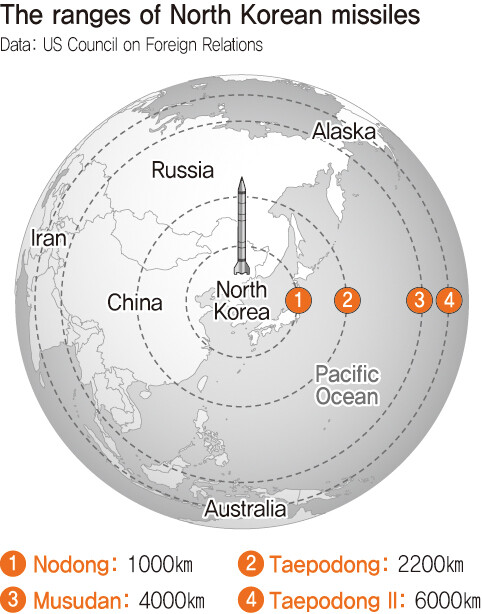hankyoreh
Links to other country sites 다른 나라 사이트 링크
US to boost missile defense in response to North Korean threats

By Park Hyun, Washington correspondent
The US has announced plans to deploy 14 additional ground-based interceptors (GBI) on its West Coast by 2017. The move is a response to advancements in North Korea’s nuclear and missile programs. The new interceptors would represent a 47% increase over the 30 that are already deployed.
In a press briefing held on Mar. 15 (EST), Chuck Hagel, US secretary of defense, explained the reasons for the decision. “The United States has missile defense systems in place to protect us from limited ICBM attacks,” Hagel said. “But North Korea in particular has recently made advances in its capabilities and is engaged in a series of irresponsible and reckless provocations.”
At present, the US has deployed 26 and 4 missile interceptors respectively at Fort Greely, Alaska, and Vandenberg Air Force Base, California. The 14 additional interceptors are planned to be positioned at Fort Greely. The plan to deploy additional interceptors had been put on hold by US President Barack Obama in 2009, but this indicates that that decision has been reserved and that the plan will now be implemented.
“We believe the KN-08 probably does have the range to reach the United States,” said James Winnefeld, vice chairman of the joint chiefs of staff, referring to the mobile missile that North Korea unveiled in Apr. 2012. “The (North) Korean threat went just a little bit faster than we might have expected,” Winnefeld said.
It also appears that the measure is intended to send a warning message to China. On Mar. 16, the New York Times quoted officials in the administration who said that this was a warning to China that it must either control its ally North Korea, or face increasing US military power in Asia.
In fact, the US Department of Defense said that it will deploy SM-3 ballistic missile interceptors in Japan in addition to the TPY-2 X-band ballistic missile tracking radar it had already planned to place there.
When asked about trilateral cooperation, James Miller, US Under Secretary of Defense for Policy, did not conceal the fact that the US, South Korea, and Japan are moving toward the development of a trilateral missile defense network. “We’ve had very strong bilateral discussions with both Japan and with South Korea,” James said, “and we’ve begun to initiate some trilateral discussions as well.”
It was also announced during the briefing that the US would be conducting an environmental impact study at three sites with a view to constructing an additional ground-based interceptor launch base in the continental US.
The US Defense Department is planning to cover the costs of implementing these plans, which total around US$1 billion, by restructuring missile defense plans in Europe. In effect, this will involve canceling the stage-four plans to deploy mid- and long-range SM-3 IIB interceptors in Poland by 2022. Russia had strongly opposed the stage-four plans, contending that they resulted in a weakening of its nuclear capabilities.
This move is expected to help ease conflict between the US and Russia and to have a positive influence on bilateral talks to reduce the nuclear stockpiles of the two countries.
Please direct questions or comments to [english@hani.co.kr]

Editorial・opinion
![[Editorial] Does Yoon think the Korean public is wrong? [Editorial] Does Yoon think the Korean public is wrong?](https://flexible.img.hani.co.kr/flexible/normal/500/300/imgdb/original/2024/0417/8517133419684774.jpg) [Editorial] Does Yoon think the Korean public is wrong?
[Editorial] Does Yoon think the Korean public is wrong?![[Editorial] As it bolsters its alliance with US, Japan must be accountable for past [Editorial] As it bolsters its alliance with US, Japan must be accountable for past](https://flexible.img.hani.co.kr/flexible/normal/500/300/imgdb/original/2024/0417/6817133413968321.jpg) [Editorial] As it bolsters its alliance with US, Japan must be accountable for past
[Editorial] As it bolsters its alliance with US, Japan must be accountable for past- [Guest essay] Amending the Constitution is Yoon’s key to leaving office in public’s good graces
- [Editorial] 10 years on, lessons of Sewol tragedy must never be forgotten
- [Column] A death blow to Korea’s prosecutor politics
- [Correspondent’s column] The US and the end of Japanese pacifism
- [Guest essay] How Korea turned its trainee doctors into monsters
- [Guest essay] As someone who helped forge Seoul-Moscow ties, their status today troubles me
- [Editorial] Koreans sent a loud and clear message to Yoon
- [Column] In Korea’s midterm elections, it’s time for accountability
Most viewed articles
- 1[Column] The clock is ticking for Korea’s first lady
- 2Samsung barricades office as unionized workers strike for better conditions
- 3[Editorial] When the choice is kids or career, Korea will never overcome birth rate woes
- 4[News analysis] After elections, prosecutorial reform will likely make legislative agenda
- 5S. Korea, Japan reaffirm commitment to strengthening trilateral ties with US
- 6Japan officially says compensation of Korean forced laborers isn’t its responsibility
- 7Why Israel isn’t hitting Iran with immediate retaliation
- 8[Editorial] Does Yoon think the Korean public is wrong?
- 9[Guest essay] How Korea turned its trainee doctors into monsters
- 10[Guest essay] Amending the Constitution is Yoon’s key to leaving office in public’s good graces